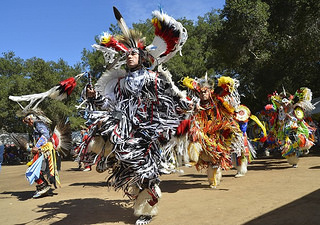The Chumash people
The Chumash and Gabrielino-Tongva peoples were the first human inhabitants of the Channel Islands and Santa Monica Mountains areas. They are known to have lived here for thousands of years and are believed to first come to the area in 30,000 b.c.; numerous archaeological sites have been uncovered in the past decade. The Chumash and Gabrielino-Tongva peoples visited present-day Azusa Street and downtown Los Angeles regularly to visit the Los Angeles river, however, they are not thought to have established a village in the area because the Los Angeles River flooded the valley regularly prior to being altered by future settlers.
There were about 20,000 Chumash living in an area that covered California’s coast from Malibu in the South, to San Luis Obispo in the North. The successful livelihood of the Chumash people was based upon their subsistence upon the available natural resources – plants, animals and fish, and their sustainable ways of utilizing these resources. They found use for almost every type of plant and animal available – for food, clothing, medicine and tools. Their environment inspired their art (Chumash rock and cave art still exists today), their beliefs, stories, ceremonies and songs. The rich history and lifeways of the Chumash people is preserved in those art forms, which were passed down to the children of each generation.
The Chumash were a maritime culture, known as hunters and gatherers. Their boats – canoes, called tomols, enabled them to fish and trade, traveling up and down the coast to other villages. Tomols were usually constructed from redwood logs. The Chumash were not dependent upon farming, as were other Native American tribes. Acorns, seeds, bulbs, roots and nuts were abundant, as were wild game, including bears, seals, otters, shellfish, deer and rabbits.
Chumash homes were called aps, and were constructed of local plant materials. Baskets and mats were woven, and bones and plants were used for tools and clothing. The Chumash were extremely innovative and resourceful, and found uses for everything that was available, including each part of almost every plant.
The Chumash also developed a variety of games, which were designed to teach the young about sportsmanship and skills useful for hunting and making crafts. Stories were told to teach the children about their relationship with nature, and their cultural and religious beliefs.
The Chumash culture was one of the most unique and advanced in the continent, and there is much to learn from a people who understood the relationship between humankind and earth’s natural resources; they both feared and respected the natural world, for they knew their lives depended on it for survival.


